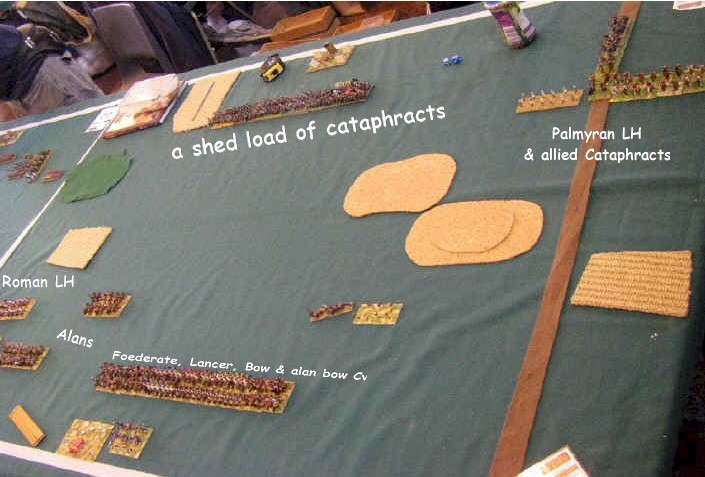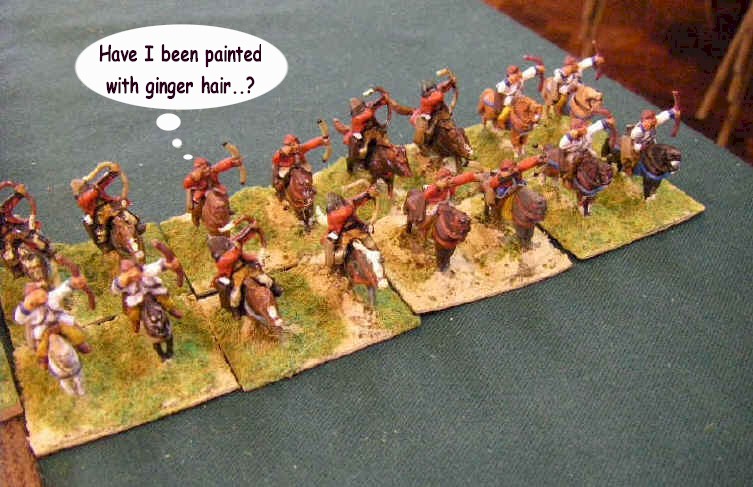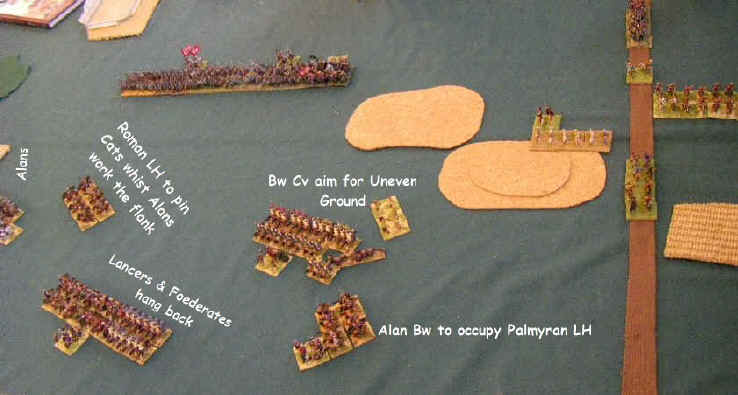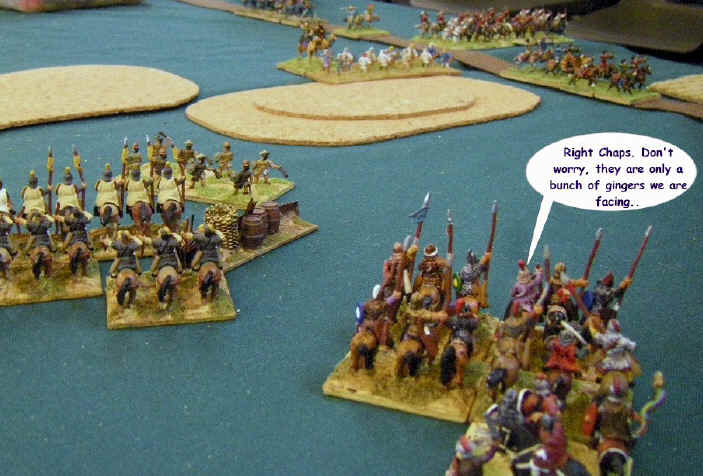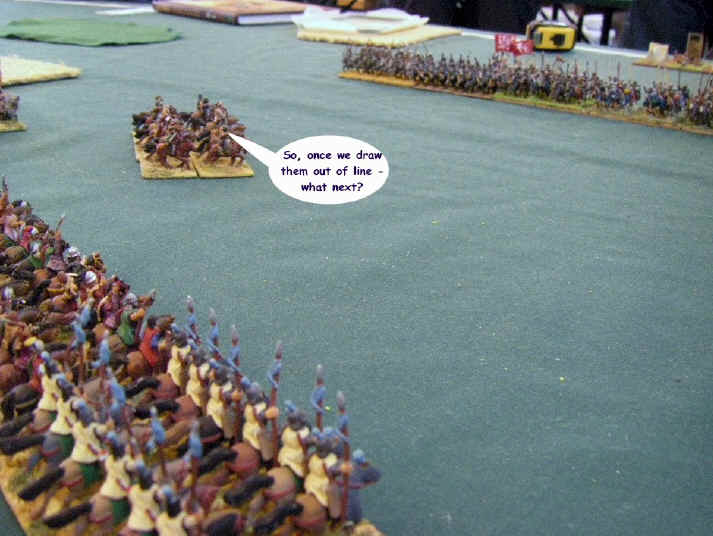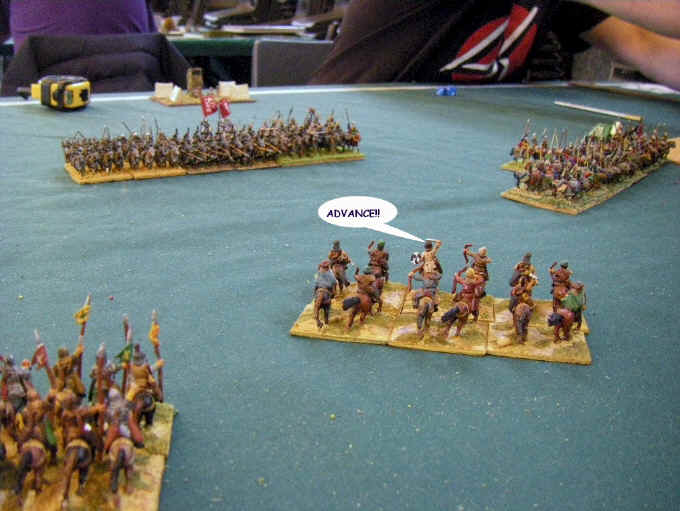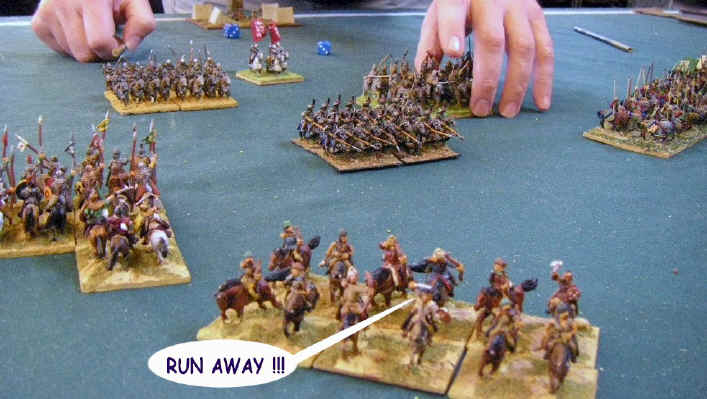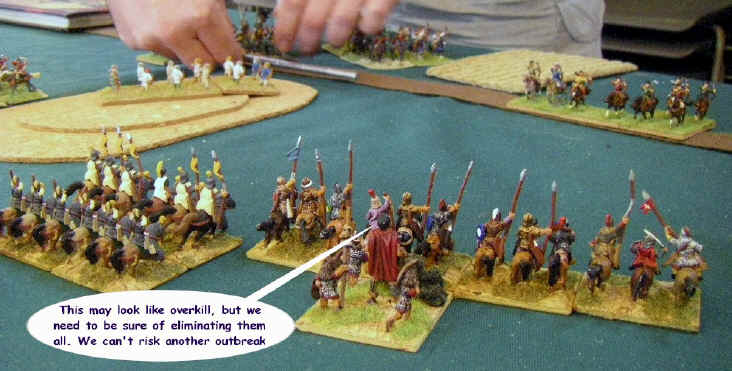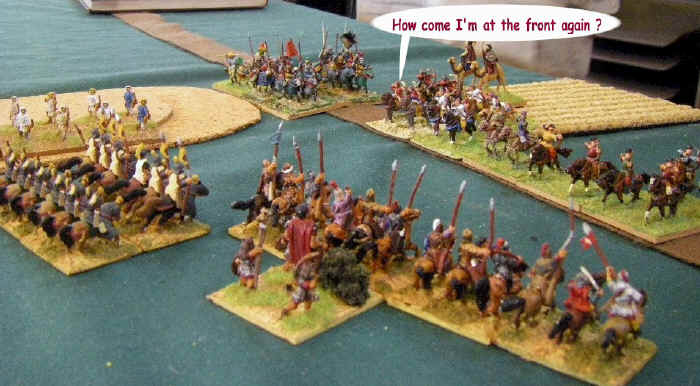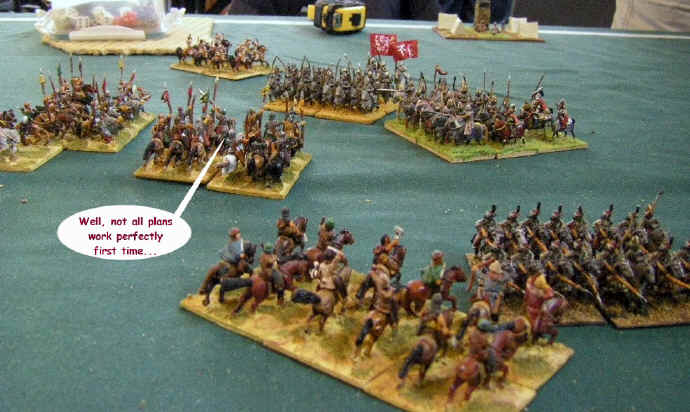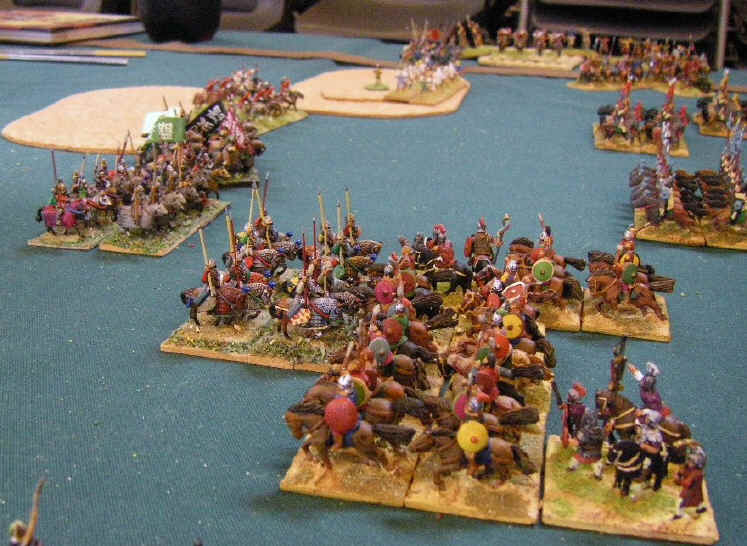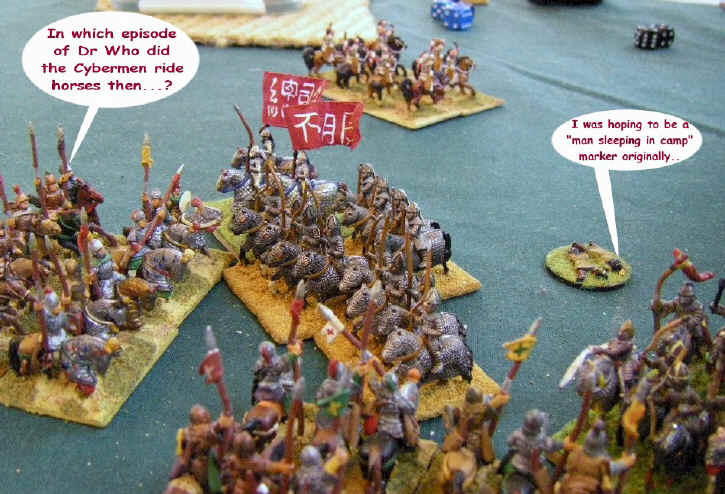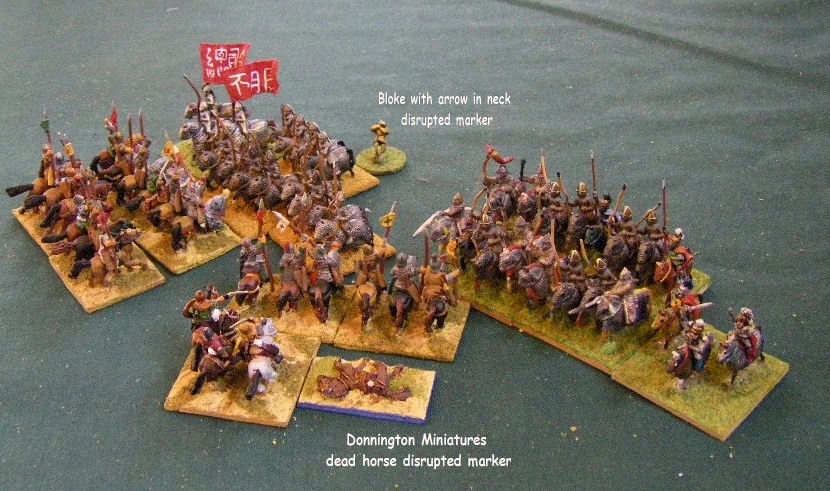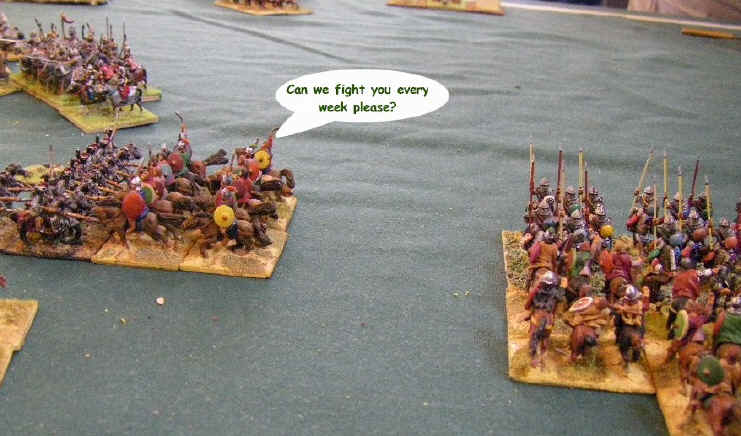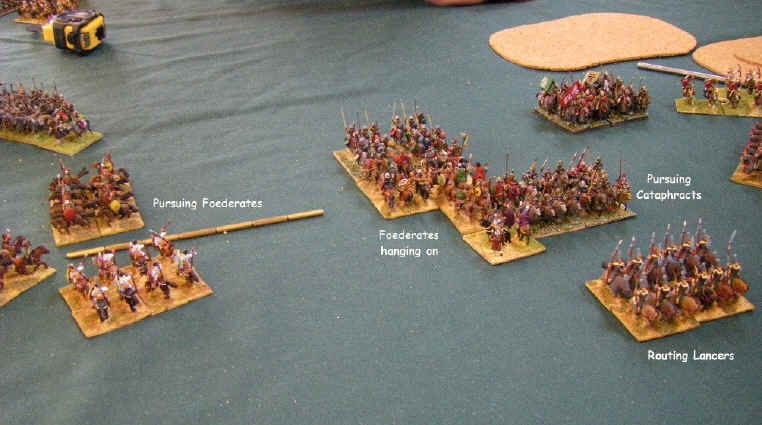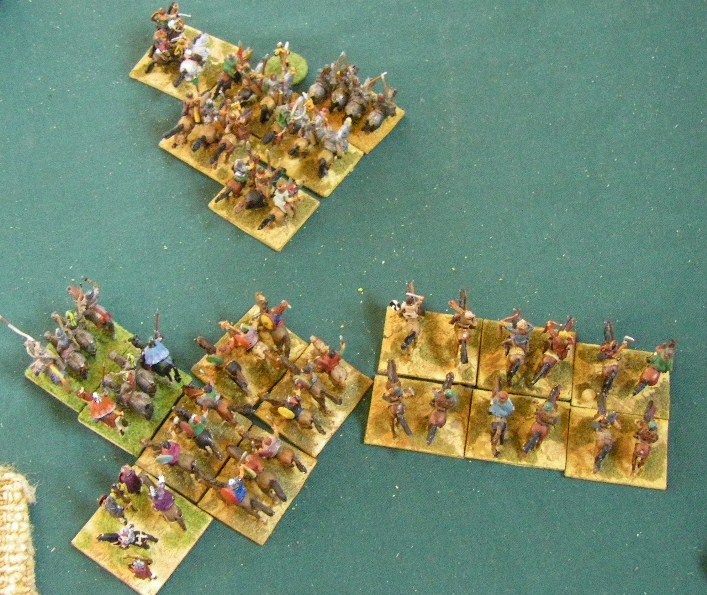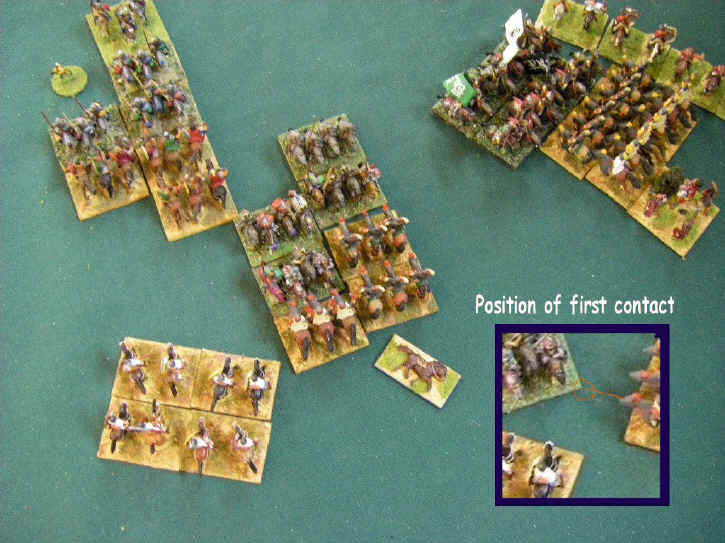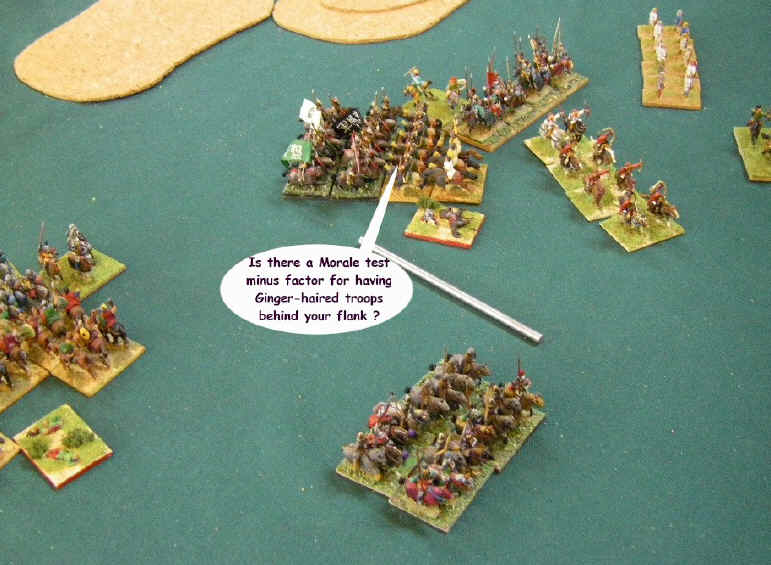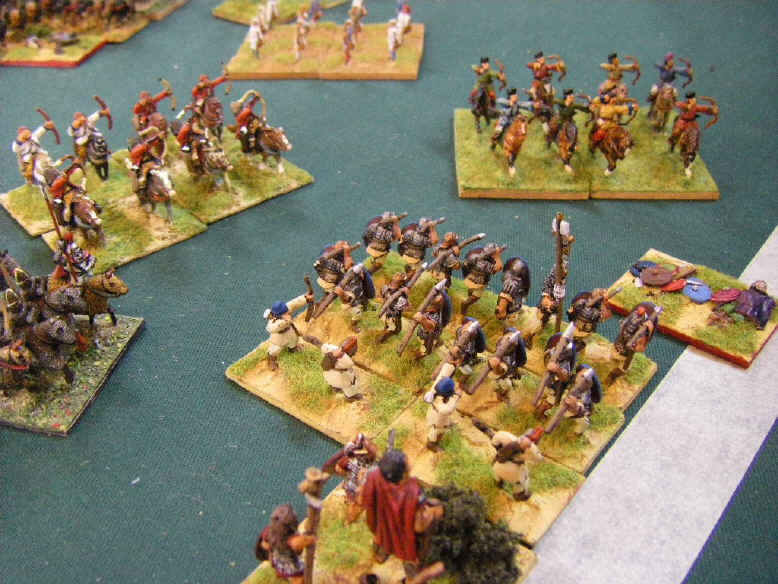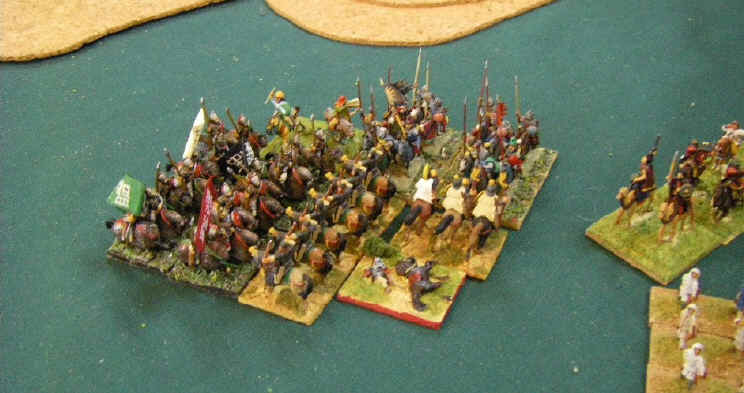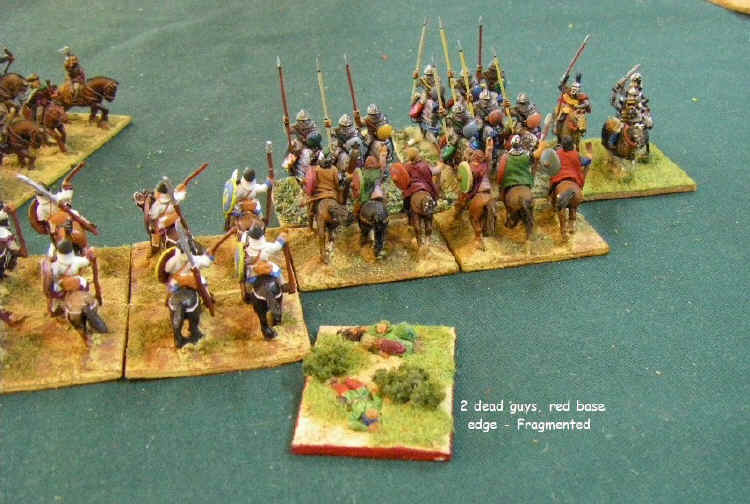Field of Glory Wargaming at Roll Call 2008
With Wycombe in driving distance of home, Saturday was disappointingly civilized. And with the clock changing that night, Sunday was almost a lie in - unheard of really!
The Sunday Morning saw me facing some more cataphracts - this time Palmyran's. So at least that was different eh?
Well, I'd beaten one cataphract army, and messed up against the other one so surely by now I would know what I was doing?
You can see the list and find out all about the Palmyrans here
Pictures of Palmyran Troops from my Ancients Photo Directory
 |
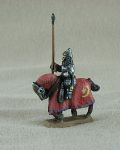 |
I'd gone for similar terrain, hoping to create some problems for the Palmyrans to move past and expose flanks - and with a steep hill and some uneven ground in a fairly prominent position things seemed promising.
My Alan allied command was also together, prolonging my flank out to the far left - all I needed to do was pick apart the cataphract units and then repeat the last game?
Well, maybe a bit harder with 28 cataphracts vs the 16 in the last game !
The Palmyrans had loaded all their light horse onto their far left, and supported it by a lone unit of cats - I really had little to oppose it as my own light horse were a bit overmatched by the sheer numbers of Palmyrans - especially with the Alans committed on the other flank.
The Palmyran light horse skirmish screen screamed forward ahead of their cataphracts, led by their commander - General Deja-Vu.
The Cataphracts had a fairly unimpeded field across which to advance, but their right flank was curiously unprotected.
But as the big block of cataphracts advanced they were moving forward inexorably - but quickly - and they showed no inclination to split up. On my left the armoured Alan lancers were motoring but still struggled to get round the flank in time.
The Palmyran light horse flank advance was effectively unstoppable, as I was likely to need all my cavalry units in the middle to deal with the mass of cataphracts - and my 2 units of LH were elsewhere anyway!
My Roman cavalry moved up boldly to try and take the patch of uneven ground
to command the Palmyrans left, and reluctantly I decided to allocate my
protected cavalry bowmen to hold up the light horse flank force.
But in the middle the cataphract line continued to sail majestically forward. With such a massive frontage the cataphracts seemed likely to just try and hoover up my army as they sailed toward the baggage!
Finally the armoured horsemen blinked, and split into two large block - this was good news. The bad news was that each block was almost as big as ALL the cataphracts I had faced the game before!
And with the light horse looking to be well out of the way, I was already struggling to see where a victory could come from ..
On my left, the Alan light horse successfully goaded some of the Palmyran cataphracts into a futile charge, breaking up the huge wall of steel. The Alan lancers were galloping desperately to try and get round the Alans flank.
Looking at what might be killable on my opponents army, and seeing the Palmyran light horse push forward far beyond their supporting cataphract guards, I allocated another unit of bow cavalry to wheel toward the flank and press the Palmyran light horse.
Suddenly I had a large amount of shooting pressing forward to try and catch the rather surprised Palmyran skirmish wing - if nothing else, this forced 2 generals to be allocated to the area by the Palmyrans - or, more accurately, it took one general away from the middle.
But on the far left, things had not worked out as well as I had hoped. The drilled Palmyran cataphracts had managed to turn on a sixpence and were now facing off my own Alans, and I had been unable to engineer a flank charge. I was starting to despair of whether they were even possible ! At least the Alans had drawn off 2 units of cataphract lancers - and my Roman light horse were off and running toward the baggage as well.
As the rest or the Cataphracts moved up, I had a change of heart about the wisdom of trying to force things on my right - and using all the maneuvering ability of my drilled bowmen, pulled them back out of the line. It meant the lone unit of protected lancers were on their own - but I was able to allocate the Inspired CinC to manage them, so hopefully they could stand up against shooting for quite some time. However realistically they were now a forlorn hope, tasked with delaying the onrushing Palmyran flank attack rather than with any real chance of achieving anything positive.
The Alans and the Palmyran cataphracts were the first troops to come to blows on the table - a mess of potential intercept charges failed to open up any flanks for me, and both units ended up engaged frontally. At least one Cataphract unit was overlapped - but so was one unit of my Alans. It looked messy...
In the middle the Palmyrans had also been tempted into a charge that would break up their line by one unit of Foederate cavalry who had pushed forward into range. I had hoped to trick the Palmyrans into a double overlap by triggering an intercept charge, but lack of detailed knowledge of the rules has meant I had messed up in this rather complex attempt to engineer a double overlap.
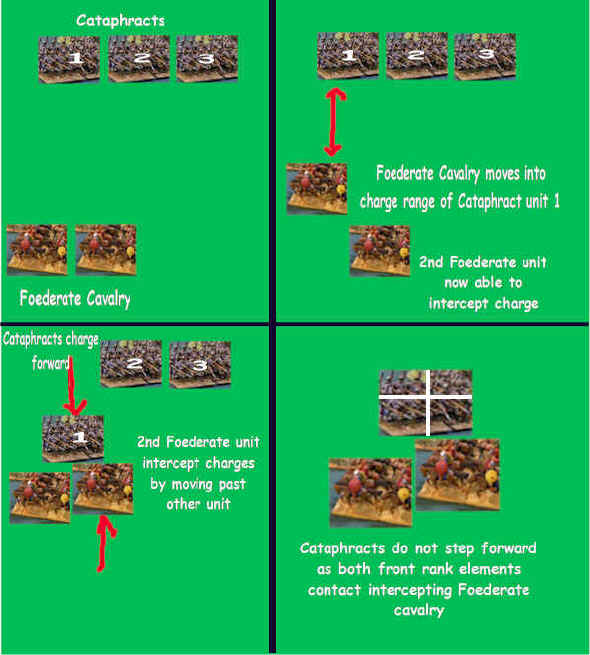
Pants!!
On the left, the Alans were fighting heroically - and after winning the initial impact (when things are all square) the Cataphracts had dropped cohesion down to fragmented, and then weight of numbers was starting to count - surely it would be only a matter of time before the Cataphracts crumbled?
The other unit of Alans was not so lucky though, and they were soon hanging on with 50% losses - and the fragmented cataphracts were recovering cohesion as the battle went on!
With the super-clever intercept charge trick not coming off, soon the Romans were embroiled in a desperate struggle with even numbers against the better quality Palmyrans. However with all 4 generals committed elsewhere, the Palmyrans needed to retain the initiative as they could not bolster these units..
The observant amongst you may now have started to wonder where the other Foederate cavalry unit has gone to ......
Magically, with the Palmyran army now separating out into individual units as they either got bogged down in combat, or chased the ghosts of the Roman light horse, the other Foederate cavalry unit found themselves presented with a far more tempting target than simply joining their colleagues as an overlap - and, working closely with the Roman light horse, managed to engineer a FLANK CHARGE!!! The shocked Palmyrans were hammered by the impact of the lancers and quickly imploded.
With one units now destroyed, there was a huge hole in the middle of the Palmyran army - but the "average" Roman lancers proved to be "sub-standard" and they too collapsed. At least they had relieved some of the pressure on the embattled Foederate cavalry, who continued to battle toe to toe against the Palmyran cataphracts (and against the odds).
The "50%" Alans resolve finally crumbled and with the Foederate cavalry breathing down their necks, half of the Palmyran cataphracts slogging it out against the Alans gratefully pursued the fleeing Alan remnants. Would they get away far enough though?
Erm, no - ! The Foederates quickly charged in and nailed their 2nd unit of the game !
Which target would the Foederates pick on next?
Back in the middle, with the obvious advantages of this "flank charge" malarkey having quickly been seen and understood by both armies, the blocks started to move around in a deadly game of Roman era Tetris. With the Roman bowmen now safely extricated from the flank, they now started to threaten the Palmyrans flanks as well - it was a desperate game of "who can get into a flanking position first?"
Remarkably, after a long, bitter and see-saw battle, losses finally counted to break the resolve of the remaining unit facing off against the Alans. The Romans now had 2 units in full pursuit - but could they actually achieve anything constructive with this crushing and total victory on the flank at this stage in the game ?
Things were looking tight, as the Romans were simply running out of units capable of taking on the Palmyrans. The 2 units of mounted bowmen drew straws, and the yellow clad troops lucked out. They closed in on one unit of cataphracts, whist their red-clad colleagues maneuvered into position to hopefully inflict a crushing flank change on some more cataphracts - who were being goaded into a rash charge by harassment from Roman mounted javelinmen.
But, despite starting behind the Cataphracts flank, the Roman charge hit the front of the unit! An intercept charge can only be straight forward, AND it can't include any stepping forward - so there was no flank contact at all ! The Roman cavalry, disheartened, compounded their tactical error by rolling poor dice and started to crumble.
In fact, both units of superior cavalry were actually performing poorly - one broke, the other fell to fragmented. The Romans had no units left in any position to rescue the situation - the entire right wing was in tatters !
The beleaguered Romans only hope was the clock - could the CinC inspire his poor auxiliary infantry to stand up against shooting long enough ...?
Maybe - but the Roman mounted bowmen were in a bad place indeed....
Finally, the Foederate cavalry in the center were ground down by the power of the Cataphracts - and they too crumbled, and with them, the Roman hope.
Post Match Summary
For a time this game seemed to be going well. The Alans had turned the flank of the cataphract line, and the Roman light horse had managed to tease them into several rash charges, breaking up their formation - however a couple of rules-based errors had then undone nearly all the good work, both through mistimed/misplaced interception charges.
The cataphracts had also proved very resilient, and even with 2 generals off messing about on the flank the Palmyrans were able to grind down the Roman (and Alan) cavalry in one-one-one combats consistently.
When the flank charges had worked out, they had been devastating - but they were fiendishly hard to engineer, and took time to tee up as well - all of which could easily be undone by a Palmyran unit passing a complex move test to either turn to flank or simply not charge.
The other areas where the Romans had come up short was against the Palmyran light horse wing - another task the Romans lacked enough of the right type of troops to deliver.
In the final reckoning, mistimed charges or not, the Roman army had simply not had enough units to hold some of the Palmyrans up by taking them on at the 2:1 odds they had achieved against the Parthians the previous day - and at the same time also work around their flanks AND chase off their light horse. So, a good effort, but one that mathematically 28 cataphracts appeared to doom to failure.
Hannibal's Post Match Analysis
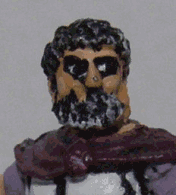
Ever read any reports of real battles? Know how us "Real" generals do things? It's not about how you shuffle the pieces on the table, its about how you get the right pieces there in the first place.
I mean, in the American Civil War, Lee was the star commander, the Rebels were the best infantry - but the Union won through better logistics, better coordinated artillery and sheer economic and manpower muscle which allowed them to mobilize resources and buy time to defeat the South strategically, and, ultimately, they then won tactically as well through good management (by Lincoln) of their roster of Generals, rotating the more successful ones into the key positions whilst the South continued to stick with the un-challengeable Lee.
Of course, I actually know nothing about that conflict at all, having died over 2000 years earlier, but my basic point still stands nevertheless. It's about bringing the right stuff to the table, and then using it well.
You failed badly here, as your army wasn't anywhere near good enough to take on 28 cataphracts. As long as the Palmyran general didn't fritter away his light horse, you were doomed to be ground into the dirt.
NEXT!!!
The stage was set for the next round
The Ancient Army List Index
The Rise of Rome (280 BC to 25 BC) Mid Republican Roman ; Late Republican Roman ; Gallic ; Pyrrhic ; Later Carthaginian ; Ancient Spanish ; Later Macedonian ; Later Seleucid ; Later Ptolemaic ; Attalid Pergamene ; Numidian or early Moorish ; Pontic ; Early Armenian ; Parthian ; Later Jewish ; Illyrian ; Spartacus Slave Revolt ; Bosporan ;
Storm of Arrows - Western Europe in the Later Middle Ages (1300 AD to 1500 AD) Medieval French ; 100-yrs War English (Continental) ; 100-yrs War English (Britain) ; Later Medieval Scots ( Britain) ; Later Medieval Scots (Continental) ; Later Scots Isles & Highlands ; Medieval Welsh ; Later Anglo-Irish ; Medieval Irish ; Low Countries ; Later Medieval German ; Italian Condotta ; Swiss ; Free Company ; Medieval Burgundian ; Medieval Danish ; Medieval Swedish ; Medieval Castilian ; Medieval Crown of Aragon ; Medieval Portugese ; Later Granadine ; Navarrese ; Ordonnance French ; Wars of the Roses English ; Ordonnance Burgundian ; Santa Hermandad Nueva Castilian
Immortal Fire - The Greek, Persian & Macedonian Wars (550 BC - 146 BC)
Classical Greek ;
Early Achaemenid Persian ;
Lydian ;
Thracian ;
Syracusan ;
Early Carthaginian ;
Skythian or Saka ;
Kyrenean Greek ;
Late Dynastic Egyptian ;
Alexandrian Macedonian ;
Later Achaemenid Persian ;
Classical Indian ;
Early Successor ;
Early Sarmatian ;
Galatian ;
Hellenistic Greek ;
Graeco-Bactrian ;
Graeco-Indian ;
Indo-Greek :
Legions Triumphant - Imperial Rome (25 BC to 493 AD) Dominate Roman ; Principate Roman ; Foederate Roman ; Later Sarmatian ; Early German ; Dacian or Carpi ; Ancient British ; Caledonian ; Early Alan ; Jewish Revolt ; Sassanid Persian ; Kushan or Indo-Skythian ; Palmyran ; Early Frankish, Alamanni, Burgundi, Limigantes, Rugian, Suevi or Turcilingi ; Western Hunnic ; Early Visigothic & Early Vandal ; Early Ostrogothic, Herul, Sciri or Taifali ; Early Anglo-Saxon, Bavarian, Frisian, Old Saxon or Thuringian ; Gepid or Early Lombard ; Early Scots Irish ; Early Pictish ; Hephthalite Hunnic ;
Swords & Scimitars - The Crusades (1096 AD to 1311 AD) Early Crusader ; Later Crusader ; Fatimid Egyptian ; Georgian ; Seljuk Turk ; Cuman ; Komnenan Byzantine ; Post Latin Conquest Byzantine ; Ilkhanid Mongol ; Mamluk Egyptian ; Cilician Armenian ; Syrian States ; Khwarazmian ; Ayyubid Egyptian ; Middle Serbian ; Middle Bulgarian ; Medieval Cypriot ; Latin Greece ; Pecheneg ;
Eternal Empire - Eastern Europe and the Rise of the Ottomans (1300 AD to 1500 AD) Early Ottoman Turkish ; Later Ottoman Turkish ; Tatar ; Later Russian ; Later Serbian Empire ; Later Bulgarian ; Later Lithuanian ; Later Polish ; Later Teutonic Knights ; Catalan Company ; Middle Hungarian ; Moldavian or Wallachian ; Albanian ; Timurid, White Sheep Turcoman or Black Sheep Turcoman ; Later Hungarian ; Hussite ;
Decline & Fall - Byzantium and Islam (493 AD to 1071 AD) Early Byzantine; Maurikian Byzantine ; Thematic Byzantine ; Nikephorian Byzantine ; Later Moorish ; Later Visigothic ; African Vandal ; Italian Ostrogothic ; Early South Slav ; Lombard ; Avar ; Arab Conquest ; Early Bulgar ; Ummayad Arab ; Abbasid Arab ; Early North African Dynasties ; Khurasanian Dynasties ; Bedouin Dynasties ; Dailami Dynasties ; Pecheneg ; Ghaznavid ; Western Turkish (includes Khazar);
Wolves From The Sea - The Hairy European Dark Ages Post Roman British ; Early Welsh ; Later Scots Irish ; Merovingian Frankish ; Later Pictish ; Early Slavic ; Middle Anglo Saxon ; Astur Leonese ; Andalusian ; Early Navarrese ; Carolingian Frankish ; Viking ; Magyar ; Great Moravian ; Early Scots ; Rus ; Norse Irish ; Early Medieval French ; Early Medieval German ; Norman ; Early Polish ; Anglo Danish ;
Swifter Than Eagles - The Biblical Book Nubian ; Early Libyan ; Later Sumerian or Akkadian ; Early Nomad Allies ; Old or Middle Kingdom Egyptian ; Hyksos ; Mitanni ; Syro-Canaanite ; New Kingdom Egyptian ; Later Minoan or Early Mycenaean ; Hittite Empire ; ; Middle or Early Neo-Assyrian ; Later Mycenaean or Trojan ; Sea Peoples ; Philistine ; Phoenician Allies ; Neo-Hittite And Aramaean ; Later Hebrew ; Mannaean Allies ; Libyan Egyptian ; Urartian ; Median ; Neo-Elamite ; Proto-Arab Allies ; Cimmerian or Early Skythian ; Neo-Assyrian Empire ; Phrygian Allies ; Kushite Egyptian ; Neo-Babylonian Empire ;
Oaf of Fealty - Early Medieval Europe Feudal Catalan and Early Crown Of Aragon ; Early Hungarian ; Taifa Andalusian ; Feudal Navarrese and Aragonese ; Feudal Castilian Leonese or Portuguese ; Fanatic Berber ; Italo-Norman ; Feudal French ; Imperial German ; Feudal German ; Communal Italian ; Papal Italian ; Early Scots Isles And Highlands ; Feudal Scots ; Early Russian ; Feudal Polish ; Anglo-Norman ; Later Welsh ; Early Lithuanian or Samogitian ; Wendish Prussian or Estonian ; Early Medieval Frisia and Other Free Cantons ; Post-Viking Scandinavian ; Early Plantagenet English ; Later Sicilian ; Early Medieval Irish ; Early Anglo-Irish ; Early Teutonic Knights ; Mongol Invasion ; Early Granadine ; Middle Plantagenet English ;
Empires of The Dragon - China, Korea and Japan Erlitou-Shang Chinese ; Early Northern Barbarian Allies ; Early Zhou Chinese ; Yayoi Japanese ; Early Horse Nomad ; Ko Choson Korean ; Warring States To Western Han Chinese ; Qiang And Di ; Three Kingdoms Korean ; Eastern Han Chinese? ; Three Kingdoms W Jin And S Dynasties Chinese ; Kofun Nara Japanese ; Northern Dynasties Chinese ; Later Hindu North Indian ; Later Hindu South Indian ; Central Asian City States ; Western Wei To Early Tang Chinese ; ; Later Horse Nomad ; Tibetan ; Nepalese Allies ; Parhae Korean ; Late Tang To Five Dynasties Chinese ; Khmer Or Champa ; Thai Allies ; Nanzhao ; Pyu Burmese Allies ; Koryo Korean ; Early Heian Japanese ; Pagan Burmese ; Liao ; Song Chinese ; Xi Xia ; Ghurid Afghan ; Jin ; Late Heian To Muromachi Japanese ; Japanese Warrior Monk Allies ; Mongol Conquest ; Moslem Indian Sultanates ; Medieval Indonesian Or Malay ; Yuan Chinese ; Medieval Burmese ; Ming Chinese ; Yi Korean
Blood and Gold - The Americas Olmec ; Teotihuacan ; West Mexican ; Zapotec or Mixtec ; Toltec ; Chinantec ; Aztec ; Tarascan ; Tlaxcalan Confederacy ; Mayan ; Mochica ; Chanca ; Chimu ; Hatun-Colla ; Canari ; Inca ; Mapuche or Araucanian ; Amazonian Forest Tribes ; Tupi ; Chichimec ; Pueblo Culture ; Mound-Builder Culture ; South-Eastern Woodland Culture ; Timucuan ; Eastern Woodland Culture ; Plains Culture ; Pacific North-West Culture
View My Stats for My FoG Pages


